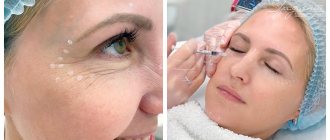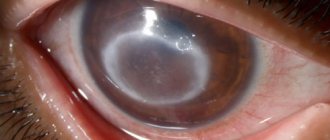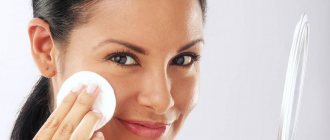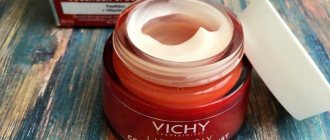The human body is a complex system that requires a number of different substances for its normal functioning. It should be noted that if the body lacks any one component, this leads to the development of diseases, disruption of the functioning of internal organs and the flow of biological processes. One of the most important components, which is the body’s energy resource, is lecithin. Without it, a person could not live, for this reason it is simply necessary to describe this substance, as well as figure out why exactly this component is needed and where to get it.
Phospholipids – emulsifiers and active substances to strengthen the skin barrier
Cosmetologists note that recently in many countries, especially in large cities, the number of people suffering from symptoms associated with conditions such as dry, sensitive or hyper-reactive skin has been increasing.
Experts associate this skin condition with disturbances in the functioning of the lipid barrier of the stratum corneum. One of the reasons for this phenomenon can be considered the content in cosmetic formulations of significant concentrations of substances that can have a destructive effect on the lipid barrier. An example of such substances is surfactants, which can work as part of a cosmetic formulation, including as emulsifiers. Another reason is the large number of aggressive polluting particles in the air of large cities, which can initiate the oxidation of sebum. As a result, the number of people who consider their skin dry, irritated and very sensitive is increasing all the time. We can say that these are people with impaired skin barrier function. In order to strengthen the barrier, it is advisable to introduce ingredients such as phospholipids, which are natural, biodegradable and multifunctional components, into cosmetic formulations. These are not only technical additives that exhibit emulsifying properties and make it possible to obtain lamellar compositions, not only substances that form liposomes, and thereby facilitate the delivery of active ingredients in cosmetics, but also moisturizing active ingredients that deliver linoleic and linolenic acids to the skin. It has been shown that linolenic acid from phospholipids penetrates quite deeply into human skin and can work as a building material - it is included in the skin’s own ceramides and helps strengthen its natural barrier function [1]. There is also evidence demonstrating that phospholipids suppress the development of acne and alleviate skin conditions such as neurodermatitis and psoriasis [1]. Today, the market for cosmetic raw materials offers a large number of products based on phospholipids, which make it possible to create ready-made compositions with optimal cosmetic properties. Moreover, these raw materials are not only imported, but also domestically produced.
Benefits for women
Lecithin has been shown to help breastfeeding mothers, and some breastfeeding experts recommend phosphatidylcholines as a treatment for preventing reocclusion of the milk ducts. For example, Canadian breastfeeding experts recommend taking 1,200 milligrams of lecithin four times a day. According to them, lecithin can reduce the thickness of breast milk, which in turn reduces the likelihood of clogged milk ducts. [5] However, lecithin supplements are not intended to treat already blocked ducts.
Chemical structure and properties of phospholipids
From a chemical point of view, phospholipids are esters of polyhydric alcohols and higher fatty acids, which contain a phosphoric acid residue and an additional group of atoms of various chemical nature connected to it, for example, choline in the case of phosphatidylcholine or ethanolamine in the case of phosphatidylethanolamine. Depending on which polyhydric alcohol underlies the structure of the phospholipid, glycerophospholipids (based on glycerol), phosphosphingolipids (based on sphingosine) and phosphoinositides (based on inositol) are distinguished. The most common glycerophospholipids in nature are phosphatidylcholine (Fig. 1), which is the main lipid of cell membranes.
Figure 1. Chemical formula and molecular model of phosphatidylcholine
All glycerophospholipids are built according to a single plan, and their molecules are sterically consistent with each other. At the same time, the huge diversity of phospholipids is provided by the variety of fatty acids that make up their molecules. Thus, there are several dozen natural types of phosphatidylcholine (Fig. 2).
Figure 2. Amphiphilic structure of the phospholipid molecule
Due to their chemical structure, phospholipids are amphiphilic molecules. The polar “head” consists of glycerol (or other polyhydric alcohol), a negatively charged phosphoric acid residue and a group of atoms attached to it, often carrying a positive charge. Nonpolar tails are fatty acid residues attached to a polyhydric alcohol by ester bonds (Figure 2). In the case of lysophospholipids (monoacyl phospholipids), only one fatty acid is attached to the glycerol residue, in this case the phospholipid molecule has a cone shape and can form micelles in an aqueous solution (Fig. 3). If the formation of an ester bond occurs along the two hydroxyl groups of glycerol, a diacylphospholipid is formed containing the residues of two fatty acid molecules. The diacylphospholipid molecule has the shape of a cylinder and in an aqueous solution forms lamellar bilayers in which the hydrophobic tails are oriented inside the layer, and the hydrophilic heads are oriented outside (Fig. 3). Thanks to this property, phospholipids are able to form biological membranes (lipid bilayer), liposomes and lamellar emulsions. In these emulsions, phospholipids form bilayers that surround and stabilize the oil droplets. This structure allows you to increase the amount of oils and other lipids in the emulsion, reduce the concentration of other emulsifiers, and the presence of an aqueous phase allows you to include water-soluble biologically active substances in the products.
Figure 3
Phospholipids are essential substances that are indispensable for humans. They are not produced in sufficient quantities in the body and must be obtained from food. Their most important function is direct participation in the construction of cell membranes. According to recent studies, most people do not receive up to 40% of the required phospholipids. The content of phospholipids in edible oils is relatively low and rarely exceeds 2%; the highest content can be noted in soybean, sunflower oils and cottonseed oil - 1.7–1.8%.
Being essential components of the biological membranes of all living cells, phospholipids are non-toxic and very well accepted by the skin.
The main causes of dull hair:
- lack of nutrients (proteins, microelements) that form the structure of the hair. This may be caused by an unhealthy diet or monotonous diet [1];
- diseases of the endocrine system [1];
- diseases of the gastrointestinal tract [1];
- dysbacteriosis and other diseases (anemia, hepatitis, worms) [1];
- improper hair care [2];
- poor ecology in the place of residence [2];
- temperature changes to which the head is exposed [2];
- stress due to frequent cosmetic procedures (coloring, styling, curling) [2];
- hormonal disorders, which also lead to the appearance of seborrheic disorders and the formation of dandruff [6]
The presence of these factors leads to the appearance of split ends, thinning of the hair structure, as well as loss of shine, since the hair scales, which when healthy reflect light and create a glossy effect, begin to flake off and cease to protect the hair from adverse effects [2]. If it is impossible to eliminate a negative factor (for example, move from an area with polluted air or cure a chronic disease), you need to use medicinal products.
Use of phospholipids in cosmetics
The most common type of phospholipid in the tissues of animals and plants is phosphatidylcholine (lecithin), which consists of structural residues of phosphoric acid, choline, fatty acids, and glycerol (Figure 1). Lecithin is also the main phospholipid used in cosmetic formulations.
Cosmetic lecithin is described as a mixture of phospholipids that consists primarily of phosphatidylcholine, but may also include components such as fatty acids, triglycerides, sterols, hydrocarbons and glycolipids. Lecithins can be fractionated by phosphatidylcholine content, ranging from "crude" lecithin, containing about 15% phosphatidylcholine and a significant amount of the vegetable oil from which the lecithin was obtained, to skim or fractionated lecithin, containing 25 to 96% phosphatidylcholine. Sources of lecithin for industry can be soybeans, eggs, milk, raw materials of marine origin, rapeseed, cotton and sunflower. The fatty acid composition of isolated phospholipids is typical for each specific type of raw material and determines the temperature at which fatty acids change their mobility. Below a point called the “gel-to-liquid crystalline transition temperature,” the fatty acids are in a rigid gel form. Above this temperature value they are mobile and are in liquid crystalline or liquid form. Phospholipids containing polyunsaturated fatty acids are characterized by a very low (below 00C) transition temperature. This means that at a temperature of 220C, these lipids are in liquid crystalline form and, upon contact with water, form very mobile structures - liposomes. Phospholipids containing unsaturated fatty acids can be converted to phospholipids containing saturated fatty acids as a result of hydrogenation. Such hydrogenated phospholipids are in a gel state at skin temperature and tend to form more rigid and stable membrane-like structures. Recently, mainly soy lecithin or lecithin obtained from other plant materials (rapeseed, sunflower) have been used in cosmetics. There is also a tendency to use lecithin that is not derived from genetically modified soybeans.
Lecithin and its derivatives have the following properties useful in cosmetics [2]:
- emulsification and solubilization
- humidification
- improving barrier function, stimulating the synthesis of ceramides in the skin
- reduction of skin irritation
- reduction in pore size
- reduction of hyperkeratosis
- stimulation of cell proliferation
- increasing the active penetration of other active ingredients into the skin
- hair conditioning supplements
- formation of liposomes and active delivery of active substances
- increased deposition of cationic dyes onto hair.
The Russian market includes both the world's leading lecithin suppliers and Russian manufacturers. The main consumption of lecithin in Russia is the food industry (more than 95%). The leaders in terms of volumes of lecithin imported to Russia are the ADM company - 46% of total imports, Cargrill (13.4%), etc.
Recipes for creams with lecithin at home
Making a skin care cosmetic at home is not difficult; you only need to purchase a couple of ingredients at the pharmacy. Products with added lecithin are suitable for any skin type. Its optimal content in creams and face masks is from 2 to 10%.
Recipes for homemade cosmetics with phospholipids:
- Moisturizing cream for all skin types. Ingredients: 7-10 g of dietary supplement "Lecithin", 30 ml of purified water, 10 ml of castor or vegetable oil, 2 ml of freshly squeezed aloe juice, propolis tincture and glycerin. First you need to soak the lecithin in water and let it swell. Then gradually add the remaining ingredients using a syringe.
- Face and hand cream (protective). Ingredients: 5 g lecithin, 25 ml mineral water, 2 g beeswax, 1 g each of vitamin E, D-panthenol and lactic acid, 10-20 drops of essential oil (optional). Soak lecithin in water with lactic acid. Then add the melted wax and oils and beat with a blender.
- Cream for dry skin. Ingredients: 5 g lecithin, 40 ml rose water, 15 ml grape seed or jojoba oil, 5 drops of your favorite essential oil. The product is prepared in the same way as the previous ones.
- Cream for sensitive skin. Ingredients: 5 g lecithin, 40 ml decoction of geranium flowers, 10 ml avocado oil, essential oil.
- Cream for oily skin. Ingredients: 5 g lecithin, 20 g rose water or chamomile decoction, 10 ml almond oil, tea tree oil. If there are many inflammations on the skin, instead of 10 ml of almonds, add 5 ml of calendula tincture.
- Anti-aging cream for dry skin. Ingredients: 5 g lecithin, 4 ml chamomile tincture, 20 ml purified water, 1 ml propolis and glycerin, 5 ml macadamia and grape seed oils.
The product is prepared in sterilized glass containers. The water base should be at room temperature. It is recommended to mix the recipe ingredients at low speed with a mixer or mini blender attachment. Stop before it reaches a creamy consistency, otherwise you will end up with milk. The resulting mass is stored in the refrigerator for no more than two weeks.
Below you can see a proven recipe for lecithin cream:
Important commercial derivatives for cosmetics
Important commercial lecithin derivatives used in cosmetics are lysolecithin, hydroxylated lecithin, lysophosphatidic acid and hydrogenated lecithin [2] .
Lysolecithin, also called lysophosphatidylcholine, is produced by partial hydrolysis of phosphatidylcholine, thereby removing one of the fatty acid residues. Lysolecithin has been shown to have good emulsifying, moisturizing and solubilizing properties, and also increases the active penetration of substances into the skin. Lysolecithin is produced for cosmetics under the following trade names: Lysofix Dry (Glycine soja (Soybean) Seed Extract) - supplier Kemin; Lecinol WS 50 (Lysolecithin, glycerin) – supplier Nikko Chemical; Alcolec EM and Alcolec C LPC 20 (Lysolecithin) - supplier American Lecithin; Emultop (Lysolecithin) is a supplier of Cargill.
Hydroxylated lecithin is produced by treating lecithin with hydrogen peroxide and organic acids, such as acetic or lactic acid. Hydroxylated lecithin is significantly more hydrophilic than regular lecithin, is very stable and has excellent moisturizing, emulsifying and solubilizing properties. Examples include Yelkin 1018 (Lecithin) from ADM and NET HS-70 (Hydroxylated lecithin, Glycerin) from Nikko Chemical.
Lysophosphatidic acid (LPA) is a phosphated ester of glycerol, which is obtained by removing choline from the lecithin molecule. LPA in cosmetics has the ability to control sebum production, reduce pores, reduce wrinkles, restore the skin barrier and enhance the penetration of actives into the skin. Nikkol Chemical offers lysophosphatidic acid for cosmetics under the brand name DisaPore 20 / BarPore 42 (Lecithin).
Hydrogenated lecithin is produced by reacting hydrogen with lecithin. The result is a very stable waxy material. The healthiest varieties contain 20-30% phosphatidylcholine and are non-irritating emulsifiers with excellent moisturizing properties. They facilitate the delivery of both oil-soluble and water-soluble assets. Hydrogenated phosphatidylcholine has pronounced hydrophilicity. One molecule of hydrogenated phosphatidylcholine is able to bind 20 molecules of water and “carry” this water into the deeper layers of the epidermis, providing a direct moisturizing effect. Hydrogenated lecithin is offered under the following trade names: Lecinol S-10 (Hydrogenated lecithin) from Nikkol Chemical; Epikuron 100/200H (Hydrogenated lecithin) from Cargill; Emulmetik 300 and 320 (Hydrogenated lecithin) from Lucas Meyer. Lipoid Cosmetics AG offers hydrogenated soy bean phosphatidylcholine under the brand name Skin Lipid Matrix (Hidrogenated soy bean phosphatidylcholine).
In Russia, raw materials for cosmetics with a high content of phospholipids are produced from chicken raw materials by the company Tehkon. Examples of its products include Lipocomp (INCI: Chicken oil) and Lipofolk (INCI: Eggs yolk extract). These formulation products are a rich source of unsaturated phospholipids (up to 75%), combat dry skin and promote deep penetration of other biologically active substances into the skin.
Prospects for the Russian lecithin market and lecithin production in Russia
There are good prospects for the development of domestic production of lecithin in Russia. What is important in the case of soy products is that we are talking about non-GMO products. Thus, in 2009, three factories were launched that began producing domestic soy lecithin: Sodruzhestvo Soya (Kaliningrad), Amuragrotsentr (Blagoveshchensk), Kubanagroprod (Tbilisskaya village, Krasnodar region). These plants have installed modern foreign-made equipment, allowing
obtain lecithin, the quality of which is not inferior to imported ones. The planned capacity of three new lecithin production facilities is quite impressive and amounts to more than 4.5 thousand tons per year, which is comparable to the volume of lecithin imports in 2008 [3]. In 2016, it is planned to launch lecithin production in the Altai Territory at the AgroSib-Razdolye enterprise. Thus, the prerequisites have been created for the gradual replacement of imported lecithin with a competitive and high-quality domestic product.
According to export forecasts, the potential of the Russian lecithin market is very large. With the active introduction of lecithin into the food, pharmaceutical and cosmetic industries, as well as the spread of lecithin for technical use, the total consumption of lecithin may increase several times. According to expert estimates, lecithin consumption by the food industry may increase 3 times to 15 thousand tons. Considering the American and European experience in the technical use of lecithin, the actual potential for growth in lecithin consumption in Russia is much higher. Experts predict that the development of the Russian market will occur along with its structural change. On the one hand, it is obvious that imported lecithins are gradually being replaced by domestic analogues. On the other hand, we can expect a change in the proportions of GMO and non-GMO lecithins on the Russian market with a significant increase in the share of non-GMO both domestic and imported lecithins. Moreover, the further development of domestic production of lecithin can reorient Russia from imports to partial exports of this product.
Reviews of licetin
Galina: lecithin for children
We started giving my son lecithin. There were problems with speech - the baby had difficulty remembering new words, and mumbled those already memorized, constantly lost concentration, and showed absolutely no interest in our improvised educational process. We decided to take him to a speech therapist. The doctor advised me to introduce lecithin into my diet. They didn’t really believe in any improvements after taking the supplement, but the result was not long in coming - concentration increased, and the baby began to chatter non-stop. We couldn't be happier.
PS It is better to give preference to liquid lecithin - it is easier for a child to take it rather than large capsules.
Katerina: lecithin for beauty
Every summer there are the same problems - due to the active sun, the face becomes covered with rashes. You understand, you want to go without makeup, but what kind of “no makeup” is there if there are inflammations all over your face. I made a strong-willed decision to make an appointment with a cosmetologist, I was afraid for a long time (what was I afraid of, one wonders). I came, thinking that they would now prescribe a long list of not particularly pleasant procedures and send me on a tour of all existing doctors, but it turned out to be much simpler: the doctor recommended starting to take lecithin in capsules. Here we must immediately say that lecithin must be of high quality - it is better to overpay a little, but be guaranteed to get a good product, than to buy a dubious product at the nearest pharmacy.
I started taking lecithin, the cosmetologist promised results in 3 months, but I noticed positive dynamics much earlier. The skin color evened out, the rashes died down, and if new ones appeared, they were not so intense. Along with the skin, the condition of nails and hair has improved.
Anna: lecithin during pregnancy
Pregnancy is, of course, a happy time and all that, but my body fundamentally disagreed with this statement: I have absolutely no strength for words, my brain refuses to process more than one stream of information, my memory has deteriorated, I have become absent-minded and irritable, a constant feeling of anxiety, like something is going to happen and I won’t be able to control it. I heard from many young mothers that they took lecithin - gynecologists advised for the proper formation of the fetus and as support for the nervous system.
I decided to try it. I bought lecithin in capsules on the Internet and took it three times a day. At first there was no result, but after a few weeks it really got better - my memory returned, absent-mindedness went away, and I had the strength to do something other than work and household chores. But the main thing here is not to abuse it and consult with specialists about everything.
Sergey: lecithin for age-related changes
With age, the body ceases to be as resilient as in youth: severe fatigue, headaches, problems with remembering new information. And I want to prolong my youth. I read about lecithin on the Internet. Well, I think it definitely won’t be worse, but I would like to improve my memory. I bought sunflower lecithin at the nearest pharmacy. Indeed, after a month of regular use of the drug, memory became better, the ability to concentrate increased, and headaches began to appear much less frequently.
Valeria: lecithin for weight loss
I have been fighting extra pounds for a long time and stubbornly: I tried everything - diets, vegetarianism, intuitive eating, and intermittent fasting... All methods seem to give an effect, but short-term. I started playing sports, the quality of my body improved, but the mark on the scales decreased slowly, I wanted to somehow speed up the process. I decided to try dietary supplements, or rather lecithin.
Indeed, the weight began to come off faster, and overall health improved (here we must pay tribute to the vitamin-rich composition).








